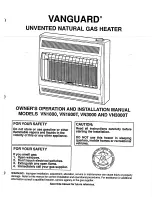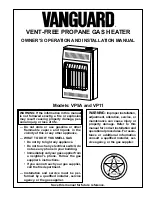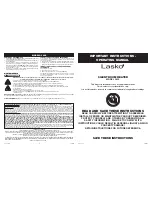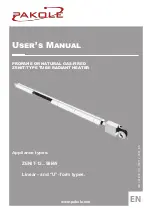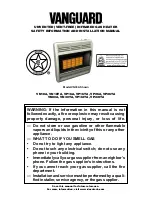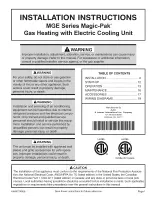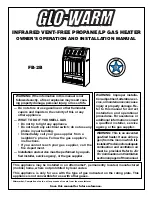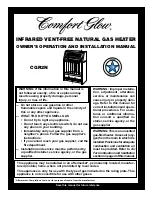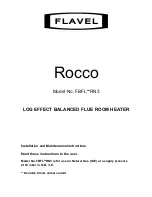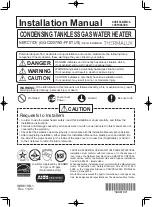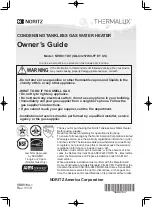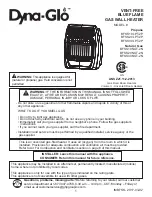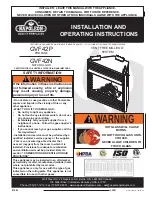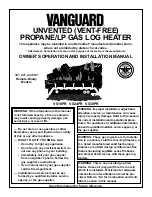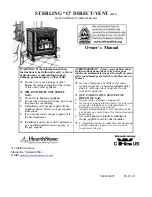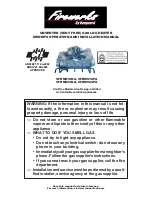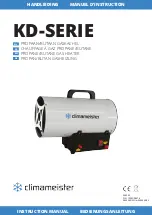
18. It is extremely important to use the proper size and
type of gas supply line to assure proper functioning of
the heater. Consult your propane gas supply service
agency for proper line sizing and installation. (See
“Pipe Sizing” example on page 10.)
19. This heater may or may not be supplied with a
regulator. Whether or not a regulator is supplied, you
should always determine if it is the proper regulator
for the specific application. A regulator must be
connected to propane tank so that gas pressure is
regulated at all times. Contact your gas supplier, or
the L. B. White Co., Inc. if there are any questions.
20. On a two-stage regulator system, the pressure
between first and second-stage regulators should not
exceed 5 psi (345 MBAR). Both regulators normally
should be mounted outside and they must be
covered.
21. It is extremely important that any regulator outside
the building be protected against the weather,
particularly ice formation. Ice formation can lead to
overpressurization of the regulator and subsequent
gas leaks. See codes covering proper protection.
22. Propane gas is heavier than air and will accumulate
in low areas causing a hazard. Therefore, tanks and
equipment should not be used where the gas could
accumulate and be a hazard.
23. The heater will not function properly unless the gas
pressure is properly regulated. Under no
circumstance should the gas pressure to the heater
exceed the burner manifold pressure rating on the
heater nameplate and owner's manual as high
pressure can cause gas leaks or an overheating of
the appliance.
24. This heater is designed for propane vapor. The
heater must never use liquid in an propane gas
application. If you are in doubt, contact the
L. B. White Co., Inc.
25. Corrosive atmospheres may cause component
failure. Animal confinement buildings are one
example of a corrosive atmosphere.
26. Eventually, like all electrical/mechanical devices, the
thermostat can fail. Thermostat failure may result in
either an underheating or overheating condition
which may damage critical products and/or cause
animal injury or death. Critical products and/or
animals should be protected by a separate back-up
control system that limits high and low temperatures
and also activates appropriate alarms.
27. Take time to understand how to operate and
maintain the heater using the owner’s manual and
your expertise as a guide. Determine how to how
shut off gas to the building and also to the individual
heater. Contact your propane gas supplier if you
have any questions.
28. Any defects found in performing any of the
service procedures must be eliminated and
defective parts replaced immediately. Retest the
heater before placing heater
back into service.
29. ALWAYS make sure the gas supply lines have been
properly purged of any contaminants (sand, pipe
cutting oil, pipe thread shavings, etc.) prior to
installation of the appliance. Use compressed air to
blow out sections of line. NEVER USE PRESSURIZED
FUEL GAS
9
GENERAL IINFORMATION
a. Black iron pipe only was used in this example as it
is less expensive per foot than copper tubing and
therefore more commonly used. However, the
same selection process using copper tubing may
be done if so desired. Refer to pipe sizing tables
specifically for copper tubing (not within this
manual). Piping planning and installation must be
done by an experienced qualified propane gas
installation agency.
b. Also, the minimum pipe size normally used in many
situations is 1/2 in. (12.7 MM) nominal. Though
smaller diameters may be available, diameters less
than 1/2 in. (12.7 MM) are normally not stocked at
L.P. gas dealers and would therefore be special
ordered, adding to overall cost.
c. The information in the pipe sizing tables was taken
from Engineered Control International, Inc., L.P. Gas
Serviceman’s Manual L545.
d. Do not attempt gas supply line selection or
installation unless you are properly trained and
qualified.
e. All gas supply lines must be leak checked after
installation and when pressurized to provide a safe
installation. Only use a certified, approved leak
detection liquid, or an ammonia-free soapy water
solution.
f. This is just one example showing how to size piping
for a building. Installation layouts differ as do the
pressures being supplied to piping, whether you are
piping for propane gas or natural gas and the
material (pipe or copper tubing) being used. Always
PIPE SIZING

























